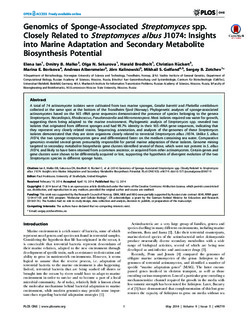| dc.contributor.author | Ian, Elena | |
| dc.contributor.author | Malko, Dmitry B. | |
| dc.contributor.author | Sekurova, Olga | |
| dc.contributor.author | Bredholt, Harald | |
| dc.contributor.author | Rückert, Christian | |
| dc.contributor.author | Borisova, Marina E. | |
| dc.contributor.author | Albersmeier, Andreas | |
| dc.contributor.author | Kalinowski, Jörn | |
| dc.contributor.author | Gelfand, Mikhail S. | |
| dc.contributor.author | Zotchev, Sergey | |
| dc.date.accessioned | 2015-11-24T12:53:37Z | |
| dc.date.accessioned | 2015-12-08T15:22:06Z | |
| dc.date.available | 2015-11-24T12:53:37Z | |
| dc.date.available | 2015-12-08T15:22:06Z | |
| dc.date.issued | 2014 | |
| dc.identifier.citation | PLoS ONE 2014, 9(5):e96719 | nb_NO |
| dc.identifier.issn | 1932-6203 | |
| dc.identifier.uri | http://hdl.handle.net/11250/2367299 | |
| dc.description.abstract | A total of 74 actinomycete isolates were cultivated from two marine sponges, Geodia barretti and Phakellia ventilabrum collected at the same spot at the bottom of the Trondheim fjord (Norway). Phylogenetic analyses of sponge-associated actinomycetes based on the 16S rRNA gene sequences demonstrated the presence of species belonging to the genera Streptomyces, Nocardiopsis, Rhodococcus, Pseudonocardia and Micromonospora. Most isolates required sea water for growth, suggesting them being adapted to the marine environment. Phylogenetic analysis of Streptomyces spp. revealed two isolates that originated from different sponges and had 99.7% identity in their 16S rRNA gene sequences, indicating that they represent very closely related strains. Sequencing, annotation, and analyses of the genomes of these Streptomyces isolates demonstrated that they are sister organisms closely related to terrestrial Streptomyces albus J1074. Unlike S. albus J1074, the two sponge streptomycetes grew and differentiated faster on the medium containing sea water. Comparative genomics revealed several genes presumably responsible for partial marine adaptation of these isolates. Genome mining targeted to secondary metabolite biosynthesis gene clusters identified several of those, which were not present in S. albus J1074, and likely to have been retained from a common ancestor, or acquired from other actinomycetes. Certain genes and gene clusters were shown to be differentially acquired or lost, supporting the hypothesis of divergent evolution of the two Streptomyces species in different sponge hosts. | nb_NO |
| dc.language.iso | eng | nb_NO |
| dc.publisher | Public Library of Science | nb_NO |
| dc.title | Genomics of Sponge-Associated Streptomyces spp. Closely Related to Streptomyces albus J1074: Insights into Marine Adaptation and Secondary Metabolite Biosynthesis Potential | nb_NO |
| dc.type | Journal article | nb_NO |
| dc.type | Peer reviewed | en_GB |
| dc.date.updated | 2015-11-24T12:53:37Z | |
| dc.source.volume | 9 | nb_NO |
| dc.source.journal | PLoS ONE | nb_NO |
| dc.source.issue | 5 | nb_NO |
| dc.identifier.doi | 10.1371/journal.pone.0096719 | |
| dc.identifier.cristin | 1154515 | |
| dc.description.localcode | © 2014 Ian et al. This is an open-access article distributed under the terms of the Creative Commons Attribution License, which permits unrestricted use, distribution, and reproduction in any medium, provided the original author and source are credited. | nb_NO |
